Inside the Dark World of Trolling

Editor's Note: The language in this story is explicit. It is also very real, lifted verbatim from actual social media messages.
"For your own safety never call a Kentucky game again. Don’t piss off Kentucky fans. We’ll make your life hell . . . ."
—Facebook message posted on the page of a business belonging to NCAA basketball referee John Higgins
The storm clouds began gathering even before North Carolina had finished off its 75–73 victory over Kentucky in the 2017 Elite Eight. By halftime of that game, which the Tar Heels would eventually win with a last-second jumper by Luke Maye, 56-year-old referee John Higgins was being lambasted online by Wildcats fans and repeatedly singled out by Kentucky’s radio play-by-play team for what the latter group deemed “inexcusable” calls. Afterward, UK coach John Calipari declared in his press conference, “It’s amazing that we were in that game where they practically fouled out my team.” Those comments hastened the gathering squall, which gained momentum overnight as it moved west to Higgins’s hometown of Omaha, where he and his wife, Carol, ran a roofing business.
The next morning, all hell broke loose. First, a video of that contest’s most controversial calls went viral. Although only one more foul was called on Kentucky than on Carolina (19-18), and even though Higgins was not involved in four of the 10 plays on the video, the four-minute, 42-second clip ended with a still image of Higgins standing next to one of his roofing trucks, along with his home and business phone numbers, and an invitation to “write a review” on his company’s Facebook page. Over the next two days, more than 700 new (and universally negative) reviews popped up, plus nearly 200 more on a Google page, where Higgins’s business rating plummeted from a nearly perfect 4.8 stars to 1.2.
Ultimately, though, it was the wave of called-in death threats, enabled by the online dissemination of Higgins’s contact info, that brought Sarpy County [Neb.] Sheriff’s investigator Matt Barrall to the scene. What made this abuse distinct from the behavior of an angry fan base in, say, 1985—or even 2005—was the volume of it all (some 3,500 calls), the speed with which it flowed and the extent to which it was fueled by social media and the internet. “I was at [Higgins’s] office for one and a half hours,” says Barrall, “and three different phone lines literally never stopped ringing. It was like that for three days straight.
“The anonymity of the internet played a huge role in this. You’re able to say these things without any repercussions. And then you can show your buddies, ‘Hey, look what I did!’ It breeds on itself. People want to one-up each other.”
In the end, the Higgins matter was a checklist of behaviors commonly associated with trolling, a nebulous, post-millennial word that refers generally to the anonymous sending of threats, insults or other harassment, usually online, from a distant remove. There were vicious Facebook messages: “You are a disgusting excuse for a sporting official.” And tweets: “I will find you. Bitch.” Fake reviews: “John personally came out to fix my roof . . . he hit on my 13-year-old son.” And, ultimately, a veiled call to retaliatory action: “The name of his company is rooferees.com,” Kentucky Sports Radio’s Matt Jones told his listeners. “R-O-O-F-E-R-E-E-S dot com.” Ultimately, Jones suggested Kentucky fans shouldn’t bother Higgins—suggestions that were followed (and perhaps negated) by more laughter-filled on-air readings of anti-Higgins messages. Altogether, the onslaught from various forms of media resulted in what Barrall called “a 21st-century version of a mob mentality.”
One of college basketball’s most respected referees, Higgins had trained himself over his 28 years on the hardwood to ignore fans’ criticisms. But nothing had prepared him for the presence of police officers stationed outside his home and business that week, or for the conversation with his 10-year-old son, who told Higgins through tears that he’d heard talk about people wanting to kill his dad. “At his age, you can’t really process that,” says Higgins, voice quaking.
Higgins says he got no support from Facebook or its harassment police. Instead, he enlisted a private company to delete the Facebook comments (and later to shut down the entire account), but the voicemails he shared with Barrall were a lasting reminder of just how far things had gone.
You’re gonna pay, buddy.
You enjoy your life before somebody kills you.
You hear that garbage truck in the background? Wish you were in it.
You should put a gun in your mouth and blow your own frickin’ brains out.
Says Higgins: “And I still had to fly to Phoenix for the Final Four.”
***
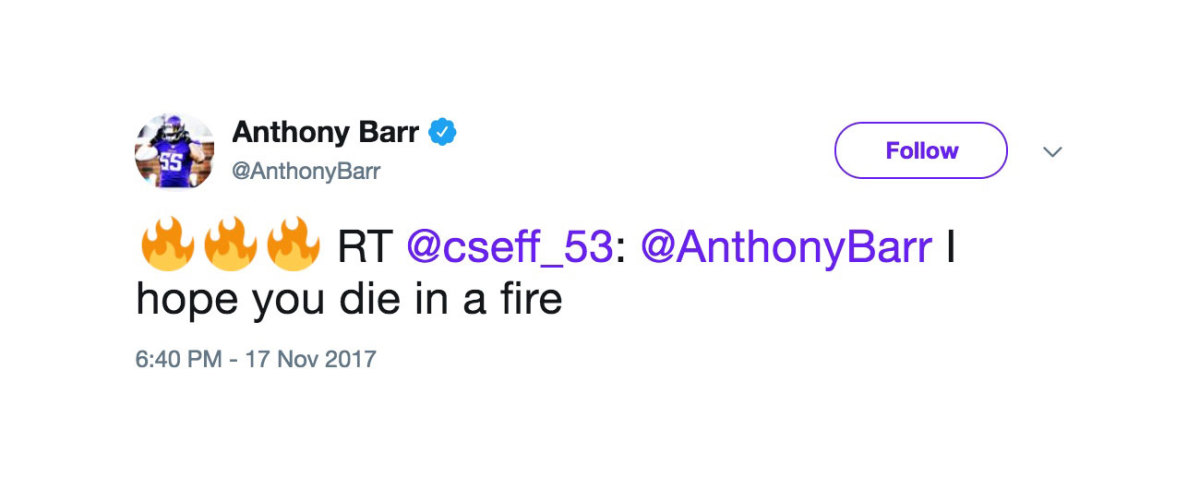
Trolling can be as difficult to quantify as it is to regulate. But one can try. In 2016 a social media analysis group called Demos looked at 80,000 randomly chosen social media accounts and over a three-week span counted more than 200,000 “aggressive tweets.” A separate study conducted jointly by Stanford and Cornell dove straight into the maw, CNN’s comments section, and discovered that most of the messages that had been flagged for abuse were posted late at night or early in the work week, when studies show that people are most likely to be in a foul mood. (Kentucky played Carolina on a Sunday night, the worst kind of timing.)
The little we’ve learned about trolling’s How much? and When?, however, dwarfs what we know about Who? and, perhaps most confoundingly, Why? What kind of person, for instance, takes out his anger at a college basketball referee by tracking down that official’s wife on Facebook in order to tell her, Your husband is a piece of trash?
Anecdotally, Barrall’s investigation revealed that the majority of offenders in the Higgins matter were white males, 18 to 25, followed by white males, 40 to 50. There were far fewer females. Those demographics align with what various researchers have found: Most trolls are young or middle-aged Caucasian men.
This, too, we know: Whatever their makeup, they generally do not enjoy being tracked down and asked about their online behavior. SI reached out to dozens of aggressive tweeters and Facebook posters, and almost universally they shied away from interview requests in one way or another, many of them going so far as to block the requester.
Typically, athletes who’ve been targeted by trolls are only slightly more interested in talking about the matter. SI contacted more than a dozen sports figures, and the majority of them declined interview requests, choosing in this instance to stick to sports rather than give their attackers the very thing that experts say trolls crave: an ounce of their attention.
Vikings linebacker Anthony Barr, whose Twitter account absorbed more abuse than usual in 2017 because of one on-field play in particular, was an exception. “Some of them are kids, some are grown men, some are old ladies,” Barr says of the authors of the worst tweets he finds in his mentions. “They go from eight to 80. Blind people have posted. I got ‘em all.”
“They look just like us,” says Kyrre Lien, a Norwegian filmmaker who spent three years studying online abusers in making the documentary short The Internet Warriors. “You wouldn’t be able to stop them in the street and say, ‘That’s a troll.’”
“The cliché is the guy in the basement,” says Karen North, a clinical and social psychologist at USC who studies online culture. “We look for the grain of truth in clichés, and the truth in that one is that a guy who lives in a basement is probably not very astute socially. Put that person in an anonymous environment where there are practically no social cues [the internet], and where there’s a lot of passion—sporting events—and we can’t be surprised that they express themselves like this.”
Old or young, basement-dweller or penthouse-level executive, “a lot of times these people are jealous of the [athlete’s] status or his ability,” says Justin Patchin, a criminal justice professor and the co-director of the Cyberbullying Research Center at Wisconsin-Eau Claire. “Used to be, fans had to keep those opinions to themselves. But over the last 10, 15 years, social media has given us the ability to interact with [sports figures] without a boundary of civility.”
“The common theme,” says Lien, the documentarian, “is that these people want desperately to be heard.”
***
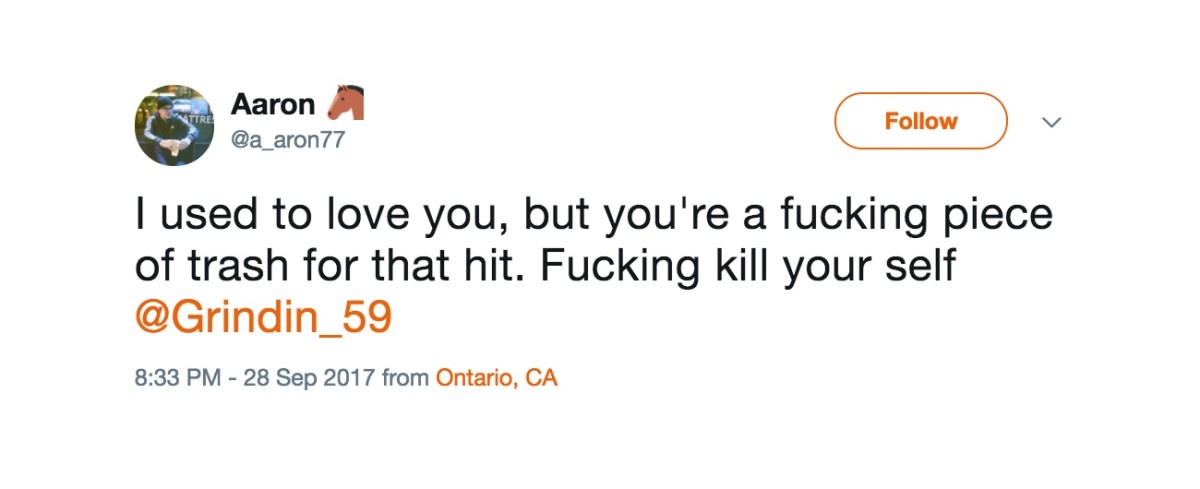
Aaron Emmerling is 19 and lives with his mother in an aboveground dwelling in the L.A. suburbs. He attends a local trade college and works as a customer service manager at a grocery store. He has a girlfriend. He appears to get plenty of sunshine. He is also a Broncos fan. “I came home from the hospital in a Denver onesie,” he says proudly.
But he tends to express this love in baffling ways. Like calling players the worst names imaginable, or advising them to take their own lives, as he did after Broncos receiver Isaiah McKenzie fumbled a punt against the Patriots last fall, writing:
AFC West rivals are fair game too (You’re a piece of shit @MelvinIngram Fucking kill yourself faggot, he tweeted at San Diego’s Pro Bowl defensive end), but Emmerling saves most of his venom for the team whose jersey he often wears while tweeting. Had Broncos president John Elway been scrolling his feed last November, during an eight-game losing streak, the most celebrated player in Denver history—a man who shook Emmerling’s hand and signed a jersey for the teenager before a 2016 preseason game—would have encountered this:
“I have fun being an internet troll,” says Emmerling. “This is how I act with my friends in real life. I’ll tell them to kill themselves or I’ll call them whatever—but I have nothing but love for them. And I have nothing but respect for Melvin Ingram. I totally understand that if [an NFL player] were in my face, there is no way I’d be saying this.”
Still, it’s one thing to tweet "WRAP HIS ASS BOOKER YOU STUPID FUCKING CUNT," as Emmerling did after Broncos special teamer Devontae Booker missed a tackle last fall. It’s quite another to tweet directly at someone, as he did in addressing Roger Goodell:
Emmerling tends to do the latter, he says, because “as bad as it is, I’d get a kick out of it if they saw it.” He remembers the time he saw McKenzie tweet back at an online critic, which led Emmerling to feel . . . jealousy. “I crave that back and forth,” he says. “I wish [McKenzie] had told me off.”
That lust for contact—even if it comes as a scolding—is at the root of this phenomenon, says Patchin. “Before social media, the only opportunity you’d have to engage with a sports figure would be to go to a game and maybe heckle or ask for an autograph,” he says. “That took work, time, money. Now you can just lift your phone and they’re right there.”
That leaves 21st-century athletes with a decision to make. Engage? And if so, how?
“Psychologically, it can be very hard to ignore hateful things being said to us,” says North. “It’s human nature to defend yourself at some point.”
Which is precisely what Todd Gurley did in 2016 when a troll using the handle @CodyHasek1 tweeted at the Rams running back: @TG3II if I ever see you in public we’re fist fighting over your fantasy football performance this year. Gurley wrote back, bluntly:
Pull up then. https://t.co/EmZBhVvZk0
— Todd Gurley II (@TG3II) December 16, 2016
We can all be grateful that Gurley’s troll (a 23-year-old male who works at the Ford plant in Harrisonville, Mo., and who, judging by his Facebook profile, appears to be in far worse physical shape than the All-Pro running back), did not, in fact, pull up—although there’s probably a maxillofacial surgeon near the Rams’ practice facility who missed out on a windfall. Still, the urge to respond the way Gurley did remains hard to resist.
Just ask Curtis Woodhouse, an English footballer-turned-boxer who in 2013 tracked down a troll who’d been peppering him for months with profane insults about his wife and his less-than-stellar results in the ring. After making the 45-minute drive to James O’Brien’s residence in Sheffield, Woodhouse tweeted out: Someone tell me what number he lives at, or do I have to knock on every door? #itsshowtime.
Fisticuffs did not ensue. O’Brien, as it happened, was at work. By the time he met Woodhouse on a TV talk show, days later, O’Brien had apologized and Woodhouse had experienced an about-face of his own. As he explained in his 2016 autobiography, “when I . . . saw him walk out I felt sorry for him. He looked so vulnerable. He was this skinny little kid shuffling on, and I suddenly felt like I was this bully.”
***
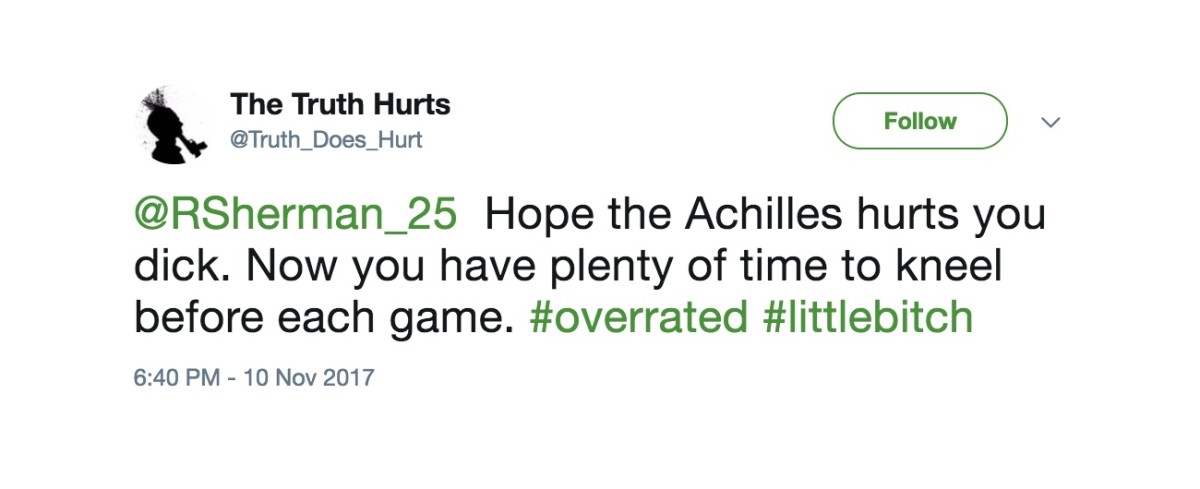
As awful as the messages were following that Kentucky-Carolina game last spring, the lowest point, says Higgins, was at the Final Four in Phoenix. “The NCAA assigned a bodyguard to me 24-7,” he says, “from the moment I got off the plane until the moment I left.” It was also around this time that Higgins began to suspect that the people who had disrupted his life—his family’s lives, and the reputation of his business—would not be held accountable.
Even when Omaha police managed to track down a handful of the trolls who’d come after Higgins, there was nowhere to file criminal charges because none of them lived in Nebraska. “There were some flat-out death threats,” says Barrall, the local sheriff’s investigator. “But current criminal statutes are not written for situations where you threaten someone’s life from 1,500 miles away.”
So Higgins—like LeBron James, major league outfielder Khris Davis, NFL linebacker Brandon Marshall and legions of other sports figures who have received anonymous death threats—had little choice but to endure the abuse. In Higgins’s case, he also had to eat the impact on his business, which for three days couldn’t contact clients by phone, which had its online reputation kneecapped and which today is still untangling the damage.
If the trolls couldn’t be held accountable, Higgins wondered, what about the media personalities who’d encouraged them? And so last October Higgins filed a civil suit against Kentucky Sports Radio and its two biggest agitators, Matt Jones and Drew Franklin, the broadcasters who’d disseminated the name of Higgins’s business website and whose own site included a link to the video that included Higgins’s phone numbers and Facebook URL. According to that suit, Jones and Franklin had spent two days encouraging thousands of potential trolls who listen to their two-hour morning show (which airs on several streaming services in addition to more than 40 traditional radio stations) by reading several abusive posts over the air, punctuated by their own laughter. Filed in Nebraska federal court, the suit alleges intentional infliction of emotional distress, invasion of privacy, tortious interference with a business relationship or expectancy, and civil conspiracy.
In a tweeted response, Jones called that lawsuit “frivolous and without any legal merit whatsoever.” Online reactions from Kentucky fans weren’t as restrained. Tweeted @cmattingly4uk, whose profile IDs him as a “PC gamer” and “Quake player”:
Zero sympathy for higgins he seemed to delibaretly call the game against ky, what a douchebag
— chris (@cmattingly4uk) October 3, 2017
Wrote another Wildcats supporter, @Tha24thLetter:
Higgins says he isn’t suing because of money, even though his suit seeks “damages [that] exceed $75,000.” He’s taking a stand, he says, against “people who have no fear of anything happening to them when they do this.”
Set off by the radio broadcast, fans “threatened my family,” he says. “They knew my kids’ ages. They knew where they go to school.
“What if I did that to them? To their children?”
***
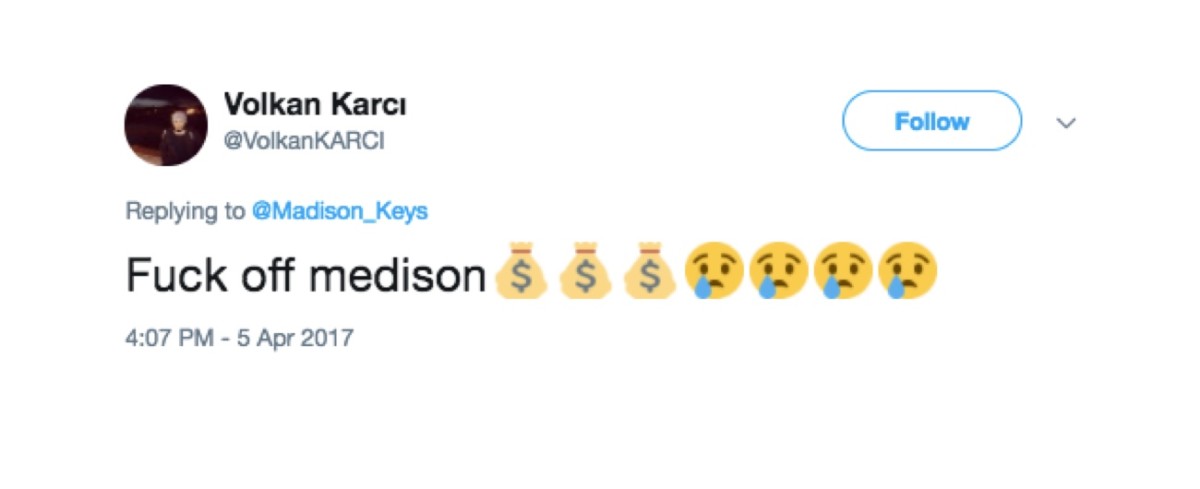
For Madison Keys, the final straw came at the 2016 China Open, in Beijing. “I had just lost to a great opponent,” says the 15th-ranked women’s tennis player in the world. “I didn’t play perfectly, but I didn’t play badly either. I got off the court and I had something like 25 Instagram messages from the same person. He had gone through every one of my pictures and written something horrible about me. I went, ‘You know what? I’m not doing this anymore.’ ”
Keys’s gauntlet had begun four years earlier, “the second I signed up for Twitter and Instagram,” she says. Keys was 17. “I thought social media was great and positive. I had never thought about the bad side.” When she did encounter trolling, she rarely responded, choosing like most athletes to ignore the vitriol. That is, until the tournament in Beijing, when she decided to start reposting the worst of the comments for all the world to see (like this now-deleted one from @AKev_94: @Madison_Keys fuck your mother bitch).
The swell of support that Keys received in return motivated her to embark on a crusade against all forms of online abuse. Among other initiatives, she partnered with Fearlessly Girl, a program that visits schools and other community groups and empowers adolescents to transcend negativity. “You don’t have to be famous to be targeted,” she says. “I have had so many mothers and daughters tell me, ‘This is an issue I’ve been dealing with and I’ve never said anything about it. And then I saw that you were doing something, so I did too.’ ”
A good number of the offensive messages Keys receives “come from people who have bet on my matches and lost,” she estimates. But plenty don’t. “Someone attacked my little sister because she didn’t congratulate me on Twitter,” she says. “It’s insane. There’s always a negative reply to whatever you post, no matter how many times you think through it and say, No one could say anything negative to this.”
Barr, the Vikings linebacker, takes Keys’s approach one step further: He’ll retweet the worst incoming comments, and then he’ll add a little lighthearted commentary intended to point out the absurdity of one play in a football game leading to dozens of death threats. In October, Barr tackled the Packers’ Aaron Rodgers a split-second after the QB released a pass, driving Rodgers’s right shoulder into the turf, breaking his collarbone and ending his season. It was a legal hit—no flag, no fine—and yet:
🤷🏾♂️ RT @Josh858: @AnthonyBarr you're a bitch. Straight up, I hope you die on the field today.
— Anthony Barr (@AnthonyBarr) November 19, 2017
“I didn’t think it would persist for this long,” Barr told SI two months later. “I thought people would say what they had to say and move on, but they still had strong feelings about it. Now I think it’s going to be like this forever.”
Barr deals with it by retweeting the worst affronts and adding condescending pats on the head, he says, “for entertainment value.” When a middle-aged Wisconsin woman (@capgal59, a “mother, friend. . . and devoted Packer fan,” per her profile) warned him about “Karma Bitch,” Barr clicked her account, caught her real name and added an exasperated “Oh marlene” at the top of his retweet. Other favorites: affixing the emojis depicting a shrugging man or hands typing on a laptop.
“If I say something rude,” Barr explains, “then I’m stooping down to their level. I’m no better than they are. But if I’m just displaying their words for everyone to see? All I can tell you is that it dies down after that. People don’t want to have that spotlight on them. They don’t like others looking them up, seeing who they are and laughing at them.”
There’s a flip side on social media, though, says North. “If [a troll] gets a sense of affirmation from just being noticed by the celebrity, then you’ve affirmed him. For a small group of people, it’s a reward.”
***
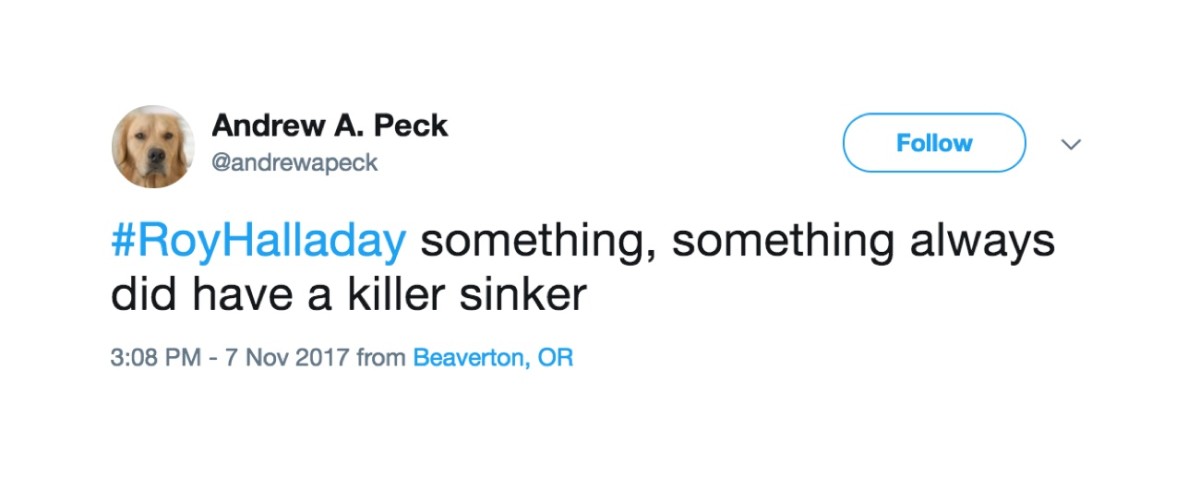
Andrew Peck is a college-educated, upper-middle-class white guy, 46 years old, who lives in the Portland suburbs in a four-bedroom home that he and his wife recently purchased for middle-six figures. The most glaring cliché about this self-admitted troll is that he has been unemployed for a couple of years. “If I had to be a suburban dad like my own dad was—if I had to cultivate a wholesome public image—I probably wouldn’t be able to do this,” he says. “But I don’t. I really don’t have to care.”
Peck breaks the mold, too, in how he goes about trolling. He’s at his most caustic when tragedy strikes the sports world, and while an athlete may come into his crosshairs, he sees that as collateral damage; his real aim is any fan who expresses sympathy. When former MLB pitcher Roy Halladay died in a plane crash last November, for example, Peck saw the outpouring of online condolences and fired off the above missive: "#RoyHalladay something, something always did have a killer sinker."
When retired NFL tight end Todd Heap tragically, and accidentally, ran over his three-year-old daughter in the driveway of his Arizona home last April and the Twitterverse expressed its condolences, Peck found himself typing into his iPhone:
the worst part was #ToddHeap arguing pass interference with the paramedic.
— Andrew Peck (@andrewapeck) April 16, 2017
“I tried six or seven different things [following the Heap incident],” says Peck. “They were all within about an hour, and they got some taunting back. I kind of encourage it. I love the outrage.
Guess #ToddHeap wasn't driving a 'Dodge'
— Andrew Peck (@andrewapeck) April 16, 2017
“To me, being a troll means playing a public role. It means saying a startling thing that. . . breaks down the tyranny of being publicly acceptable. A troll is like the court jester, the knave. He would say horrible shit about powerful people, right to their faces. If he was clever about it, he’d reveal some truth. That’s what a troll can do.
“I love pointing out hypocrisy. White-knighting—people who express condolences not because they feel something, but because it’s the thing to do. I don’t like the idea of causing Todd Heap more pain, but I wasn’t talking to him any more than people are talking to Hitler when they make a Hitler joke.”
***
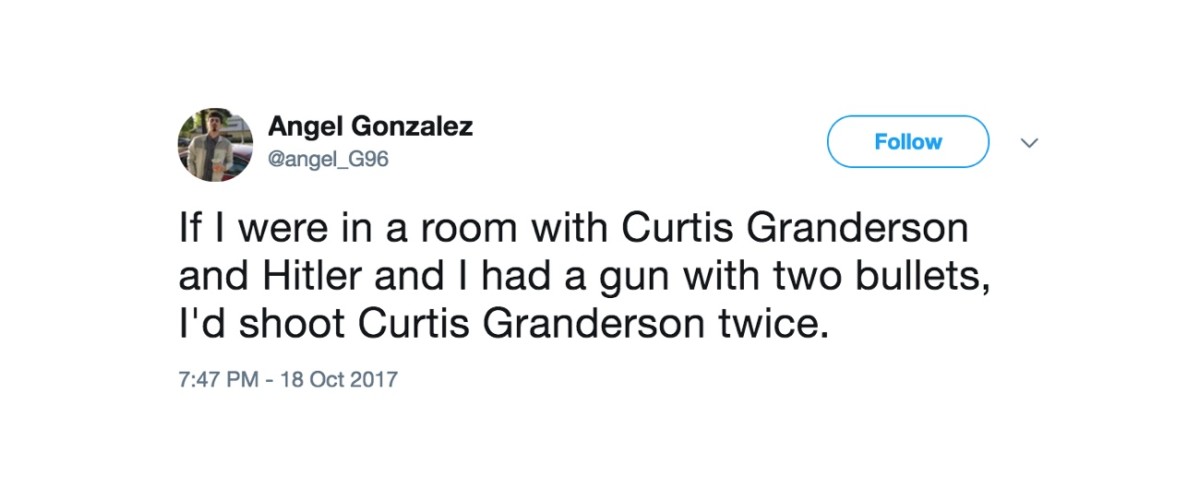
Whether trolls see themselves as online avengers or harmless satirists, the athletes who are forced to confront these often vile messages tend to wonder the same thing, regardless of whether they respond with a retweet or a lawsuit: Shouldn’t this all be more regulated?
Keys, for one, believes social media outfits like Twitter should curtail trolling “by making certain messages impossible to send out. If [a tweet] includes certain words or phrases,” she says, “maybe it could just bounce back.” For her part, she has installed several filters on her own accounts, blocking messages with trigger words.
Barr disagrees. He has no such filters. “We have freedom of speech,” he says, “and the same goes for social media.”
The English soccer club Arsenal drew a line in that freedom in 2016 by mailing an old-fashioned letter (remember those?) to fans who were particularly abusive on Twitter, informing offenders that “representatives from the club have viewed [your] tweets and find them both offensive and inappropriate, bringing the name and reputation of the club into disrepute, and therefore deem it appropriate to impose a club ban on you.” Lofty language aside, would, say, the Bills or the football program at Ohio State even have enough letterhead for such a crackdown?
Facebook, too, addresses trolls on a case by case basis; Peck says the company took a semi-stance against him for contributing to a conversation about racism with an ill-considered Hitler “joke.” He says he was banned for a day. And he did not handle it well. “I’ve been on social media for 10 years,” he says. “I’d never been banned before. Social media means a lot to me. It’s a little lonely not working. I can’t get banned.”
But a ban isn’t always a deterrent. “Oh, that is the peak,” says Emmerling, who recalls with excitement the one-day “sentence” he served for his Melvin Ingram missive. “Besides a player clapping back at me, that’s the peak.”
How long will the 19-year-old Emmerling continue ranting to his 554-and-counting followers? Will he be doing it into his 40s, like Peck? “At the rate I do it,” he sighs, “to change it would be like [stopping] smoking. It would definitely be tough.”
Emmerling, when asked about the internal switch that gets flipped between the times he praises Broncos players on social media and the instances when he advises them to commit suicide, takes a moment to reflect. Confronted with the emotions of others—of his heroes, in this case—his inner troll seems to recede and his voice softens. “You really just broke my heart and tore me down,” he says. “I totally understand where you’re coming from. . . . When I was up close to the Broncos’ players [at that 2016 preseason game], I was so grateful to the organization. If Von Miller was right next to me I never could have said that to him. Ever. . . . I feel like a dick. If I said that stuff to my girlfriend, I wouldn’t have a girlfriend.”
Upon deeper introspection, he wonders if some of his online tendencies might have been handed down to him. “My dad would get really mad” during a particularly poor stretch around 2010 when Kyle Orton was Denver’s quarterback, he explains. “He doesn’t have a filter. I adopted a bunch of things from him that I really shouldn’t have.”
For what it’s worth, Peck can relate. He tells the story of his great grandfather, a career Army officer who was “a troll before there was even an internet. He gave a scathing personnel review of his troops that”—according to a 1921 story in The New York Times—“cost him a promotion to lieutenant colonel. . . . When I was a kid my dad showed that to me and said, ‘This is what we’re like. We offend people. It’s just instinct.’ ”
“I’ve been this way all my life,” he says. “I’m not proud of it. I’ve had girls break up with me [over that]. I had a friend ask me not to come to our high school reunion because I offended someone’s wife online. It has cost me. But with the price I’ve paid, I feel I’ve earned the right to speak my piece. And I will.”
***
The biggest change in John Higgins’s life since the storm of last season is the officiating assignments he chooses. None of the 70-odd regular season games he called this year were anywhere near Lexington, Ky. His regional NCAA tournament games were in San Diego.
He probably won’t be able to steer clear of the Bluegrass State altogether, though. In January, Nebraska judge Robert Rossiter granted a motion by the defense to move Higgins’s civil case to Kentucky, essentially turning the referee’s quest for justice into a road game in a hostile gym. Most experts, including Damon McCoy, an assistant professor at the NYU Center for Cybersecurity, believe Higgins’s case will be as difficult to win as his trolls were to track down. “Unless it’s an instance of swatting,” McCoy says, referring to the trollish crime of calling a SWAT team to a fake emergency, “there is usually no legal recourse.”
Barrall, the Omaha Sheriff’s investigator, describes his search for Higgins’s trolls: “I was able to contact some of them because the phone numbers they called from were their work numbers. But most of them hung up on me.” He says one woman that he tracked down admitted to leaving Higgins a message; she did it because a friend shared that original viral video with her. “I just got caught up in it all,” she said. “I didn’t think what I was doing was disruptive.” (Her message? “Something to the effect of, ‘You need to dig a hole and bury yourself in it,’ ” says Barrall. “Nothing too bad.”)
And what of the faceless person who told Carol Higgins on Facebook, “Your husband is a piece of trash”? That particular troll made the mistake of writing from an account with a full name attached. A few clicks reveal a 38-year-old male college graduate, clean cut and fit, who is in a relationship with a college-educated woman. Public records searches turned up no home or cell numbers, but according to his Facebook page he recently began working for a local cell phone provider in Kentucky.
Contacted at work and asked if he has a few moments to discuss the Higgins matter, he lowers his voice to a whisper and, retreating beneath his figurative bridge, says, “No. No, I don’t.”
